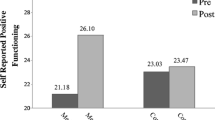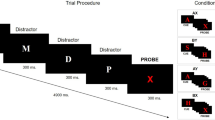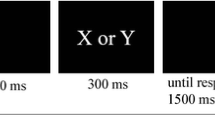Abstract
Interventions that utilize mindfulness assume that higher dispositional mindfulness is associated with greater cognitive functioning. However, few studies have specifically examined the relationship between mindfulness and cognitive performance. Evidence indicates that domains of mindfulness are related to specific cognitive functions independently; however, these data have not been replicated. The aim of the study was to reexamine the association between facets of mindfulness and cognitive abilities: perception and cognitive flexibility. Participants (N = 192) completed the Five Factor Mindfulness Questionnaire and computerized tasks of perceptual skill and cognitive flexibility. Results indicate that the nonreactivity component, but not the observing, as hypothesized, was related to perception. In contrast, none of the facets of mindfulness demonstrated a significant relationship with performance on a task of cognitive flexibility. The results suggest that the relationship between cognitive processes and facets of mindfulness may not be as clear as previously suggested.
Similar content being viewed by others
References
Anderson, N., Lau, M., Segal, Z. V., & Bishop, S. (2007). Mindfulness-based stress reduction and attentional control. Clinical Psychology & Psychotherapy, 14, 449–463. doi:10.1002/cpp.
Anicha, C. L., Ode, S., Moeller, S. K., & Robinson, M. D. (2012). Toward a cognitive view of trait mindfulness: Distinct cognitive skills predict its observing and nonreactivity facets. Journal of Personality, 80(2), 255–285. doi:10.1111/j.1467-6494.2011.00722.x.
Arnsten, A. F. T., & Robbins, T. W. (2002). Neurochemical modulation of prefrontal cortical function in humans and animals. In principles of frontal lobe function (pp. 51–84). New York: Oxford University Press. doi:10.1093/acprof:oso/9780195134971.003.0004.
Baer, R. A. (2003). Mindfulness training as a clinical intervention: a conceptual and empirical review. Clinical Psychology: Science and Practice, 10(2), 125–143. doi:10.1093/clipsy/bpg015.
Baer, R. A. (2011). Measuring mindfulness. Contemporary Buddhism, 12(1), 241–261. doi:10.1080/14639947.2011.564842.
Baer, R. A., Smith, G. T., & Allen, K. B. (2004). Assessment of mindfulness by self-report: the Kentucky Inventory of Mindfulness Skills. Assessment, 11(3), 191–206. doi:10.1177/1073191104268029.
Baer, R. A., Smith, G. T., Hopkins, J., Krietemeyer, J., & Toney, L. (2006). Using self-report assessment methods to explore facets of mindfulness. Assessment, 13(1), 27–45. doi:10.1177/1073191105283504.
Baer, R. A., Smith, G. T., Lynkins, E., Button, D., Krietemeyer, J., Sauer, S., et al. (2008). Construct validity of the Five Facet Mindfulness Questionnaire in meditating and nonmeditating samples. Assessment, 15(3), 329–342. doi:10.1177/1073191107313003.
Baer, R. A., Walsh, E., & Lykins, E. L. B. (2009). Assessment of mindfulness. In F. Didonna (Ed.), Clinical handbook of mindfulness (Vol. 1, pp. 153–170). New York: Springer. doi:10.1017/CBO9781107415324.004.
Bishop, S. R., Lau, M., Shapiro, S., Carlson, L., Anderson, N. D., Carmody, J., et al. (2004). Mindfulness: a proposed operational definition. Clinical Psychology: Science and Practice, 11, 230–241. doi:10.1093/clipsy/bph077.
Brown, K. W., & Ryan, R. M. (2004). Perils and promise in defining and measuring mindfulness: observations from experience. Clinical Psychology: Science and Practice, 11(3), 242–248. doi:10.1093/clipsy/bph078.
Brown, K. W., Ryan, R. M., & Creswell, J. D. (2007). Mindfulness: theoretical foundations and evidence for its salutary effects. Psychological Inquiry, 18(4), 211–237. doi:10.1080/10478400701598298.
Cardaciotto, L., Herbert, J. D., Forman, E. M., Moitra, E., & Farrow, V. (2008). The assessment of present-moment awareness and acceptance: The Philadelphia Mindfulness Scale. Assessment, 15, 204–223. doi:10.1177/1073191107311467.
Cattell, R. B. (1965). The scientific study of personality. Chicago: Aldine.
Christopher, M. S., Neuser, N. J., Michael, P. G., & Baitmangalkar, A. (2012). Exploring the psychometric properties of the Five Facet Mindfulness Questionnaire. Mindfulness, 3(2), 124–131. doi:10.1007/s12671-011-0086-x.
Didonna, F. (2009). Clinical handbook of mindfulness (Vol. 1, 1st ed.). New York, New York: Springer. doi:10.1017/CBO9781107415324.004.
Figueroa, I. J., & Youmans, R. J. (2011). Developing an easy-to-administer, objective, and valid assessment of cognitive flexibility. Proceedings of the Human Factors and Ergonomics Society Annual Meeting, 55(1), 944–948. doi:10.1177/1071181311551196.
Gonzalez, C. A., Figueroa, I. J., Bellows, B. G., Rhodes, D., & Youmans, R. J. (2013). A new behavioral measure of cognitive flexibility. In International conference on engineering psychology and cognitive ergonomics (pp. 297–306). Berlin: Springer.
Jha, A. P., Krompinger, J., & Baime, M. J. (2007). Mindfulness training modifies subsystems of attention. Cognitive, Affective, & Behavioral Neuroscience, 7(2), 109–119. doi:10.3758/CABN.7.2.109.
Kabat-Zinn, J. (1994). Mindfulness-based inner city community stress reduction clinic: final narrative and financial report. Worcester: Worcester.
Kabat-Zinn, J. (2003). Mindfulness-based interventions in context: past, present, and future. Clinical Psychology: Science and Practice, 10(2), 144–156. doi:10.1093/clipsy/bpg016.
Kabat-Zinn, J. (2009). Full catastrophe living: using the wisdom of your body and mind to face stress, pain, and illness. New York City, New York: Delta.
Miller, E. K., & Cohen, J. D. (2001). An integrative theory of prefrontal cortex function. Annual Review of Neuroscience, 24(1), 167–202. doi:10.1146/annurev.neuro.24.1.167.
Neter, J., Wasserman, W., & Kutner, M. H. (1990). Applied statistical models. Burr Ridge, IL: Richard D. Irwin, Inc.
Posner, M. I., & Rothbart, M. K. (2007). Research on attention networks as a model for the integration of psychological science. Annual Review of Psychology, 58, 1–23. doi:10.1146/annurev.psych.58.110405.085516.
Robinson, M. D., & Neighbors, C. (2006). Catching the mind in action: Implicit methods in personality research and assessment. In M. Eid & E. Diener (Eds.), Handbook of multimethod measurement in psychology (pp. 115–125). Washington, DC: American Psychological Association.
Segal, Z. V., Williams, J. M. G., & Teasdale, J. D. (2002). Mindfulness-based cognitive therapy for depression: A new approach to preventing relapse. New York: Guilford Press.
Shapiro, S. L., & Schwartz, G. E. R. (1999). Intentional systemic mindfulness: an integrative model for self-regulation and health. Advances in Mind-Body Medicine, 16(2), 128–134.
Shapiro, S. L., & Schwartz, G. E. (2000). The role of intention in self-regulation: Toward intentional systemic mindfulness. In M. Boekaerts, P. R. Pintrich, & M. Zeiden (Eds.), Handbook of self-regulation (1st ed., pp. 253–273). San Diego, CA: Academic Press. doi:10.1016/B978-012109890-2/50037-8.
Shore, D. I., Spence, C., & Klein, R. M. (2001). Visual prior entry. Psychological Science, 12(3), 205–212. doi:10.1021/ic960259b.
Teasdale, J. D. (1999). Metacognition, mindfulness and the modification of mood disorders. Clinical Psychology and Psychotherapy, 6, 146–155. doi:10.1002/(SICI)1099-0879(199905)6:2<146::AID-CPP195>3.0.CO;2-E.
Funding
This project was not conducted in relation to internal or external grant funding.
Author information
Authors and Affiliations
Corresponding author
Ethics declarations
All procedures performed in studies involving human participants were in accordance with the ethical standards of the institutional and/or national research committee and with the 1964 Helsinki declaration and its later amendments or comparable ethical standards. The institutional review board approval number for the present study was 2013-14003. This article does not contain any studies with animals performed by any of the authors. Informed consent was obtained from all individual participants included in the study.
Rights and permissions
About this article
Cite this article
Klein, K.P., Lancaster, S.L. Reexamining the Association Between Facets of Mindfulness and Cognitive Performance. J Cogn Enhanc 1, 345–351 (2017). https://doi.org/10.1007/s41465-017-0037-0
Received:
Accepted:
Published:
Issue Date:
DOI: https://doi.org/10.1007/s41465-017-0037-0




